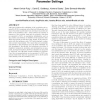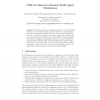430 search results - page 66 / 86 » Active Inference in Concept Learning |
GECCO
2007
Springer
14 years 4 months ago
2007
Springer
This paper analyzes the scalability of the population size required in XCS to maintain niches that are infrequently activated. Facetwise models have been developed to predict the ...
AAAI
2012
12 years 11 days ago
2012
We propose to model relative attributes1 that capture the relationships between images and objects in terms of human-nameable visual properties. For example, the models can captur...
WWW
2006
ACM
14 years 10 months ago
2006
ACM
The asymmetry of activity in virtual communities is of great interest. While participation in the activities of virtual communities is crucial for a community's survival and ...
CEEMAS
2001
Springer
14 years 2 months ago
2001
Springer
Developing multi-agent simulations seems to be rather straight forward, as active entities in the original correspond to active agents in the model. Thus plausible behaviors can be...
JUCS
2010
13 years 8 months ago
2010
: Classical classification and clustering based on equivalence relations are very important tools in decision-making. An equivalence relation is usually determined by properties of...


